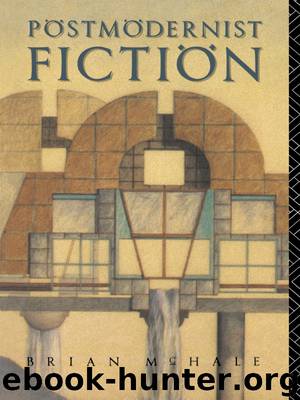Postmodernist Fiction by McHale Brian;

Author:McHale, Brian; [BRIAN MCHALE]
Language: eng
Format: epub
Publisher: Routledge
Published: 2011-09-10T16:00:00+00:00
Which reel?43
Postmodernist fiction shares with classic modernist fiction an affinity for cinema (and more recently for television), drawing upon it for models and raw materials. There are radical differences, however, in the uses to which modernism and postmodernism have put the movies. For modernist fiction, the movies served primarily as a source for new techniques of representation.44 Such modernist cinematic techniques as cinemontage do persist in postmodernist fiction, of course, but they are no longer the most important or conspicuous function of the cinema model. Instead of serving as a repertoire of representational techniques, the movies and television appear in postmodernist writing as an ontological level: a world-within-the-world, often one in competition with the primary diegetic world of the text, or a plane interposed between the level of verbal representation and the level of the “real.” Postmodernist fiction at its most mimetic holds the mirror up to everyday life in advanced industrial societies, where reality is pervaded by the “miniature escape fantasies” of television and the movies. The plural ontology of television-dominated everyday life appears, for instance, in Robert Coover’s “The Babysitter” (from Pricksongs and Descants, 1969) and Walter Abish’s “Ardor/Awe/Atrocity” (from In The Future Perfect, 1977); here the ubiquitous television set, a world within the world, further destabilizes an already fluid and unstable fictional reality.
In a television-oriented culture like the one that postmodernist writing so often reflects, TV and the movies constitute a privileged source for the sort of conceits that threaten to overwhelm the primary, literal reality (see pp.). After all, if the culture as a whole seems to hover between reality and televised fictions, what could be more appropriate than for the texts of that culture to hover between literal reality and a cinematic or television metaphor? Pynchon, for instance, uses this strategy of suspension throughout Gravity’s Rainbow, often turning to cinema for his metaphorical vehicles. Pynchon’s movie metaphors are developed so concretely and at such length that we begin to lose sight of the literal reality of which they are supposedly the vehicle:
Of course Cherrycoke is cdd. He laughs too often. Not aimlessly either, but directed at something h nks everyone else can see too. All of us watching some wry newsrpei, beam from the projector falling milky-white, thickening with smoke m briers and cheroots, Abdullas and Woodbines …the lit profiles of memary personnel and young ladies are the edges of clouds: the manly crepe of an overseas cap knifing forward into the darkened cinema, the shiny rounding of a silk leg tossed lazily toe-in between two seats in the row ahead, the keen-shadowed turbans of velvet and feathering eyelashes beneath. Among these nights’ faint and lusting couples, Ronald Cherry coke’s laughing and bearing his loneliness, brittle, easily crazed, oozing gum from the cracks, a strange mac of most unstable plastic.45
The distinction between literal reality and metaphorical vehicle becomes increasingly indeterminate, until we are left wondering whether the movie reality is only a trope after all, or belongs to the “real” world of this fiction. This
Download
This site does not store any files on its server. We only index and link to content provided by other sites. Please contact the content providers to delete copyright contents if any and email us, we'll remove relevant links or contents immediately.
| Ancient & Classical | Arthurian Romance |
| Beat Generation | Feminist |
| Gothic & Romantic | LGBT |
| Medieval | Modern |
| Modernism | Postmodernism |
| Renaissance | Shakespeare |
| Surrealism | Victorian |
4 3 2 1: A Novel by Paul Auster(11049)
The handmaid's tale by Margaret Atwood(6852)
Giovanni's Room by James Baldwin(5878)
Big Magic: Creative Living Beyond Fear by Elizabeth Gilbert(4723)
Asking the Right Questions: A Guide to Critical Thinking by M. Neil Browne & Stuart M. Keeley(4574)
On Writing A Memoir of the Craft by Stephen King(4213)
Ego Is the Enemy by Ryan Holiday(3991)
Ken Follett - World without end by Ken Follett(3972)
The Body: A Guide for Occupants by Bill Bryson(3801)
Bluets by Maggie Nelson(3710)
Adulting by Kelly Williams Brown(3670)
Guilty Pleasures by Laurell K Hamilton(3586)
Eat That Frog! by Brian Tracy(3514)
White Noise - A Novel by Don DeLillo(3435)
The Poetry of Pablo Neruda by Pablo Neruda(3367)
Alive: The Story of the Andes Survivors by Piers Paul Read(3310)
The Bookshop by Penelope Fitzgerald(3226)
The Book of Joy by Dalai Lama(3217)
Fingerprints of the Gods by Graham Hancock(3212)
